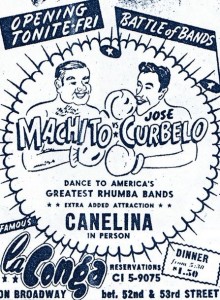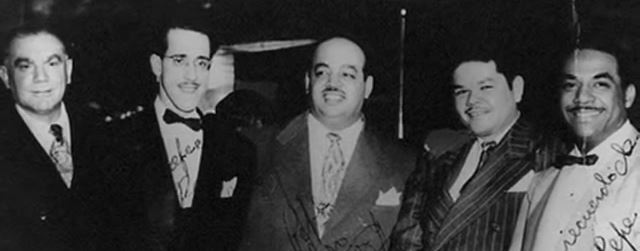Noro Morales, Jose Curbelo, and Machito were Latin music original big 3 in New York City during the early 1940s. This was before Puente and Rodriguez became big.
Latin Music Big 3; Noro, Curbelo, and Machito
The book I’m reading is “Mambo Diablo: My Years with Tito Puente” by Joe Conzo, Sr. In the book, Joe narrates how Tito Puente was part of the Jose Curbelo orchestra in the 1940s. Curbelo was one of the bands that dominated the New York Latin scene at the time. Curbelo, along with Machito, who was also starting up his Afro Cubans, and Noro Morales were the big names at that time. For some reason, Xavier Cugat’s orchestra, which had a lot of influence in the Latin scene at the time, was not considered.
Jose Curbelo
Jose Curbelo was a great Cuban pianist and bandleader. He formed the Orquesta Havana Riverside, one of Cuba’s prime bands of the 1930s and beyond. He moved to New York in 1939, and by 1942 formed his own band. In it he had at some time musicians like Candido Camero, Tito Puente, and Tito Rodriguez. Curbelo basically “retired” from playing and directing his band in 1959. He then became a full-time promoter from 1960 onward.
Here’s a video of Jose Curbelo’s “Rumba Rumbero”, singing a young Tito Rodriguez.
Noro Morales
Noro Morales was a Puerto Rican pianist and bandleader. He earned the nickname of “Rumba Man”. He moved to New York in 1937, and by 1938 re-named his family band (Los Hermanos Morales) to Noro Morales and his Orchestra. A fantastic musician admired for his sense of rhythm, he was one of the first that could play the rhythm and melody simultaneously.
Morales benefited from his friendship with follow Puerto Rican Rafael Hernandez, who lived in his same apartment building. Hernandez would go to Morales apartment to get help with some compositions. For that, Noro got the privilege to play them first. His band was at the climax of the Latin scene during the 1940’s and 50’s. Noro continued playing with some success until his premature death in 1964 at the age of only 53.
Many of the best musicians played in Noro’s band. One of his first singers was Davilita, and later he hired Pellin Rodriguez. Pellin had two stints with the band, one in 1947 and later in early 1960s when both Morales and Pellin moved to Puerto Rico. Noro Morales was also known as the Latin Duke Ellington.
Frank “Machito” Grillo
Machito is perhaps the best known of these original Big 3 for contemporary Latin music fans like myself. He moved to New York in 1937, and after singing with several bands, including the Xavier Cugat Orchestra, he finally formed his big band Afro-Cubans with fellow Cuban Mario Bauza in 1940. From then on, he became a premier name in Latin music. He had some of the best musicians of the time play in his Afro Cubans, including Tito Puente.
Puente and Rodriguez where bandmates with Curbelo

Tito Puente and Tito Rodriguez were bandmates at Jose Curbelo’s band. In the book “Mambo Diablo“, Joe Conzo does his best to demystify the supposed rivalry between these two. Actually, they seemed to have a good friendship, although some friendly musical rivalry was obvious. This was natural as both were premier bands of the 1950’s.
Tito Rodriguez formed his band in 1947, followed by Tito Puente in 1948. The Palladium opened its doors to Latin bands starting in 1947.
So the bands we know as the Big 3, were Machito, Tito Puente, and Tito Rodriguez, who benefited from the explosion of Latin music in the late 1940’s and through the 1950’s with the Palladium Ballroom venue, and the “mambo” craze!
So the Big 3 were the 2nd Big 3
Jose Curbelo, Noro Morales, and Machito where perhaps the first Big 3. But in those days there where also artists like Xavier Cugat, Arsenio Rodriguez, Miguelito Valdez, and even Desi Arnaz who helped shape the Latin music of the 1930s, 40’s, 50’s and beyond. Consequently, it seems like this big wave of Latin music of the late 30’s and through the 40’s, gave way to the 2nd wave of great Latin bands from the late 1940s through the 1960’s. Additionally, this 2nd wave of Machito, Puente, and Rodriguez would prelude the big Salsa and Latin Jazz wave of the 70’s and 80’s.
I find this musical history fascinating and perhaps will continue this line of blogs by focusing on the contributions of some of these maestros of Latin music I’ve mentioned above!


It’s a great idea to continue these types of blogs, I also encourage you to recommend
books that would lead to further knowledge and enjoyment of the music.
Dig what you do,thank you!
Thanks for the feedback! I will continue these kind of blogs as I find it a way to preserve our Latin music and culture alive.
Hi Hector!
As you alluded, Xavier Cugat was definitely the biggest Latin American music star in the United States during the 1940s. In fact, the Big 3 of the ’40s you cited, before the Big 3 of the Palladium, don’t start to achieve real notoriety until the late 1940s. In my opinion, the top 5 “Latin” artists/entertainers to initiate the 1940s decade were 1. Xavier Cugat 2. Diosa Costello 3. Miguelito Valdes. 4. Johnny Rodriguez and 5. Daniel Santos. By 1946 several others achieve a similar level of fame and join the aforementioned to establish a larger celebrity “farandula.” The Lecuona Cuban Boys (who were extremely popular and on an international level), Desi Arnaz, Bobby Capo, and, of course, the cats you mentioned (Noro Morales, Jose Curbelo and Machito). Bands led by Noro’s brother Esy, Marcelino Guerra (my favorite of the era), Pupi Campo, Servando Diaz, Bartolo Hernandez, Catalino Rolon and Carlos Molina, among others, were also vying for the top spot.
BTW-The official opening of the Palladium ballroom took place on April 15, 1946. Two bands, one led by Herbie Fields and a smaller ensemble led by a Puerto Rican trumpeter named Enrique “Quique” or “Kiki” Garcia, launched the “live” music at the Palladium ballroom. On June 12th, 1947, Machito and the Afro Cubans replace the Garcia ensemble. Like Garcia, they would be the only “Latin” band providing Afro-Cuban music until mid-September of that year. They would return in November of 1947. On December 7th, 1947, Federico Pagani and a handful of other promoters known as the “Blen Blen Club” promote a Sunday matinee to capture the same scene and attract the same crowd who were filling up the Manhattan Center ballroom on Sundays, hosted by the “Tico-Tico Club.” Who were another dance promotional consortium comprised of record label owner & producer Gabriel Oller, Radio disc jockey and co-founder of the Tico Record label, Art “Pancho” Raymond, and another gentleman whose name escapes me. Most people credit 1947 as the starting date for the Palladium because that is when the genesis of the Machito orchestra and Federico Pagani at the Palladium begin. But the Palladium ballroom, as a business, opens in 1946.
Best,
Richie Blondet
My husband is the grandson of Catalino Rolon. I’ve been doing research over the last few years and would love to be directed to any information or resources on his career. I know that he played with Xavier Cugar and later was a manager promoter for the Palladium. I would be interested to learn about how he got his start and how he transitioned from performer to promoter/manager of the Palladium. I find all of this history fascinating and learning of all the other musicians as well.
Hi, unfortunately I don’t know anything about Catalino. Sounds an interesting quest. Good luck!